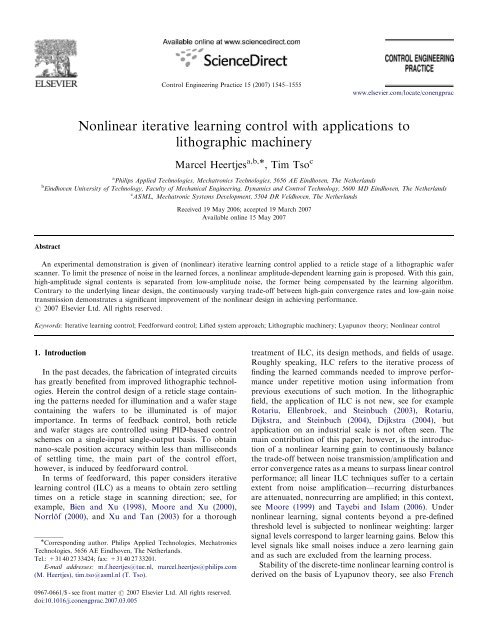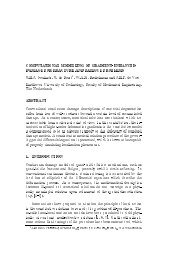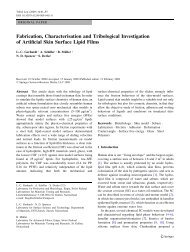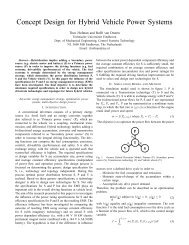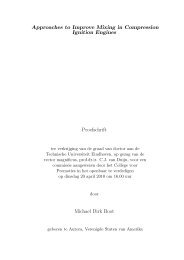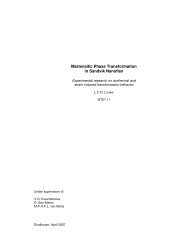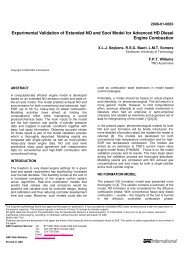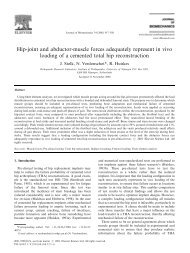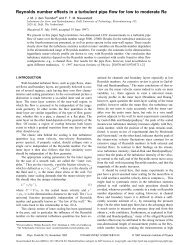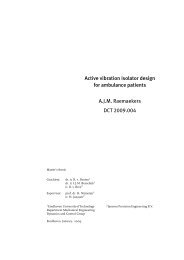Nonlinear iterative learning control with applications to lithographic ...
Nonlinear iterative learning control with applications to lithographic ...
Nonlinear iterative learning control with applications to lithographic ...
Create successful ePaper yourself
Turn your PDF publications into a flip-book with our unique Google optimized e-Paper software.
ARTICLE IN PRESSControl Engineering Practice 15 (2007) 1545–1555www.elsevier.com/locate/conengprac<strong>Nonlinear</strong> <strong>iterative</strong> <strong>learning</strong> <strong>control</strong> <strong>with</strong> <strong>applications</strong> <strong>to</strong><strong>lithographic</strong> machineryMarcel Heertjes a,b, , Tim Tso ca Philips Applied Technologies, Mechatronics Technologies, 5656 AE Eindhoven, The Netherlandsb Eindhoven University of Technology, Faculty of Mechanical Engineering, Dynamics and Control Technology, 5600 MD Eindhoven, The Netherlandsc ASML, Mechatronic Systems Development, 5504 DR Veldhoven, The NetherlandsReceived 19 May 2006; accepted 19 March 2007Available online 15 May 2007AbstractAn experimental demonstration is given of (nonlinear) <strong>iterative</strong> <strong>learning</strong> <strong>control</strong> applied <strong>to</strong> a reticle stage of a <strong>lithographic</strong> waferscanner. To limit the presence of noise in the learned forces, a nonlinear amplitude-dependent <strong>learning</strong> gain is proposed. With this gain,high-amplitude signal contents is separated from low-amplitude noise, the former being compensated by the <strong>learning</strong> algorithm.Contrary <strong>to</strong> the underlying linear design, the continuously varying trade-off between high-gain convergence rates and low-gain noisetransmission demonstrates a significant improvement of the nonlinear design in achieving performance.r 2007 Elsevier Ltd. All rights reserved.Keywords: Iterative <strong>learning</strong> <strong>control</strong>; Feedforward <strong>control</strong>; Lifted system approach; Lithographic machinery; Lyapunov theory; <strong>Nonlinear</strong> <strong>control</strong>1. IntroductionIn the past decades, the fabrication of integrated circuitshas greatly benefited from improved <strong>lithographic</strong> technologies.Herein the <strong>control</strong> design of a reticle stage containingthe patterns needed for illumination and a wafer stagecontaining the wafers <strong>to</strong> be illuminated is of majorimportance. In terms of feedback <strong>control</strong>, both reticleand wafer stages are <strong>control</strong>led using PID-based <strong>control</strong>schemes on a single-input single-output basis. To obtainnano-scale position accuracy <strong>with</strong>in less than millisecondsof settling time, the main part of the <strong>control</strong> effort,however, is induced by feedforward <strong>control</strong>.In terms of feedforward, this paper considers <strong>iterative</strong><strong>learning</strong> <strong>control</strong> (ILC) as a means <strong>to</strong> obtain zero settlingtimes on a reticle stage in scanning direction; see, forexample, Bien and Xu (1998), Moore and Xu (2000),Norrlo¨f (2000), and Xu and Tan (2003) for a thorough Corresponding author. Philips Applied Technologies, MechatronicsTechnologies, 5656 AE Eindhoven, The Netherlands.Tel.: +31 40 27 33424; fax: +31 40 27 33201.E-mail addresses: m.f.heertjes@tue.nl, marcel.heertjes@philips.com(M. Heertjes), tim.tso@asml.nl (T. Tso).treatment of ILC, its design methods, and fields of usage.Roughly speaking, ILC refers <strong>to</strong> the <strong>iterative</strong> process offinding the learned commands needed <strong>to</strong> improve performanceunder repetitive motion using information fromprevious executions of such motion. In the <strong>lithographic</strong>field, the application of ILC is not new, see for exampleRotariu, Ellenbroek, and Steinbuch (2003), Rotariu,Dijkstra, and Steinbuch (2004), Dijkstra (2004), butapplication on an industrial scale is not often seen. Themain contribution of this paper, however, is the introductionof a nonlinear <strong>learning</strong> gain <strong>to</strong> continuously balancethe trade-off between noise transmission/amplification anderror convergence rates as a means <strong>to</strong> surpass linear <strong>control</strong>performance; all linear ILC techniques suffer <strong>to</strong> a certainextent from noise amplification—recurring disturbancesare attenuated, nonrecurring are amplified; in this context,see Moore (1999) and Tayebi and Islam (2006). Undernonlinear <strong>learning</strong>, signal contents beyond a pre-definedthreshold level is subjected <strong>to</strong> nonlinear weighting: largersignal levels correspond <strong>to</strong> larger <strong>learning</strong> gains. Below thislevel signals like small noises induce a zero <strong>learning</strong> gainand as such are excluded from the <strong>learning</strong> process.Stability of the discrete-time nonlinear <strong>learning</strong> <strong>control</strong> isderived on the basis of Lyapunov theory, see also French0967-0661/$ - see front matter r 2007 Elsevier Ltd. All rights reserved.doi:10.1016/j.conengprac.2007.03.005
1546ARTICLE IN PRESSM. Heertjes, T. Tso / Control Engineering Practice 15 (2007) 1545–1555and Rogers (2000) and Yakubovich, Leonov, and Gelig(2004), the latter for a recent contribution <strong>to</strong> this field.Herein a distinction is made between the nonperturbed case<strong>with</strong> no external inputs like noises and the perturbed casehaving such inputs. In both cases exponential convergenceof the <strong>learning</strong> scheme is derived as long as the servo errorsduring subsequent iterations contain elements that exceedthe pre-defined threshold level. Performance is expressed interms of convergence as well as time-domain (settling)behavior. By adapting <strong>learning</strong> gains, rates of convergenceare obtained at which the underlying linear <strong>learning</strong>schemes become unstable. In fact, nonlinear <strong>learning</strong> isshown <strong>to</strong> combine fast convergence <strong>with</strong> robust stability,see de Roover (1996), Gunnarsson and Norrlo¨f (2001), andTousain and Van de Meche´ (2001) for linear approachesbased on optimal <strong>control</strong> <strong>with</strong> a similar aim. Zero settlingis demonstrated on an industrial reticle stage module. Byitself, this significantly contributes in optimizing waferthroughput and, therefore, helps improving general performanceof <strong>lithographic</strong> machinery.The paper is organized as follows. First, the modelling,dynamics and <strong>control</strong> of a reticle stage are considered.Second, the ILC scheme is proposed including theintroduction of the nonlinear gain filter and a motivationfor nonlinear <strong>learning</strong>. Third, a Lyapunov-based stabilityand performance analysis is conducted <strong>with</strong> special focuson convergence and robustness properties. Fourth, anexperimental demonstration in time-domain is given<strong>to</strong>wards zero settling times on a reticle stage of anindustrial wafer scanner. This paper is concluded <strong>with</strong> asummary of the main findings regarding nonlinear <strong>learning</strong>in the context of <strong>lithographic</strong> machinery.wafer stage. For reasons of presentation, further discussionis limited <strong>to</strong> the reticle stage module. However, there is nofundamental reason <strong>to</strong> exclude the presented results frombeing applied <strong>to</strong> the wafer stage module, see, for example,Dijkstra and Bosgra (2002) for an approach in thisdirection.Having two key modules, the long-stroke for fastpositioning and the short-stroke for achieving positionaccuracy, see Fig. 1, the reticle stage mainly performsrepetitive (scanning) motion in the indicated y-direction.Scanning refers <strong>to</strong> motion under constant velocity (typically2:4ms 1 ) at which the process of wafer exposure takesplace. It is performed in both the positive and negativedirection <strong>with</strong>in an effective stroke of 0.3 m. The shortstrokemodule—the long-stroke merely follows the shortstrokeand as such is less relevant in the context of thispaper—contains the reticle, a quartz object <strong>with</strong> a patternof transparent and nontransparent regions; its terminologystems from retina being a light sensitive layer in the eyeball.It is <strong>control</strong>led in six degrees-of-freedom on a singleinput–single-outputbasis, see van de Wal, van Baars,Sperling, and Bosgra (2002) for a multi-input multi-outputapproach.A simplified representation of the position tracking<strong>control</strong> scheme of the short-stroke reticle stage module inscanning direction is depicted in Fig. 2. On the basis of areference signal r, an error signal e y is constructed using therelation e y ¼ r y <strong>with</strong> y the position of the consideredelectro-mechanics given by P. The error signal e y is fed in<strong>to</strong>a <strong>control</strong>ler C after which two signals are added: f ffrepresenting a simplified (inertial) feedforward signal based2. Modelling, dynamics, and <strong>control</strong> of a reticle stageIn the manufacturing of integrated circuits (ICs) waferscanners provide the means <strong>to</strong> achieve both positionaccuracy, resolution <strong>with</strong>in 70 nm, and production speed:over hundred wafers an hour each wafer containing overhundred ICs. During the scanning process light from alaser passes a reticle through a lens and on<strong>to</strong> a siliconwafer. Both reticle and wafer are part of two separatemotion <strong>control</strong>led sub-systems: the reticle stage and theFig. 2. Block-diagram representation (<strong>with</strong> s the Laplace variable) of asimplified position tracking <strong>control</strong> scheme for the short-stroke reticlestage module in scanning direction.Fig. 1. Long-stroke (left) and short-stroke (right) reticle stage modules of an industrial wafer scanner: (a) long-stroke reticle stage module, (b) short-strokereticle stage module.
ARTICLE IN PRESSM. Heertjes, T. Tso / Control Engineering Practice 15 (2007) 1545–1555 1549matrix. Both memory loop and nonlinear gain operationLðe y ðkÞÞ ¼ LUðe y ðkÞÞ form the core of the <strong>learning</strong> scheme;<strong>with</strong>out loss of generality, it should be noted that standard(robustness) Q-filters, see for example Tomizuka, Tsao,and Chew (1989), are excluded from presentation. L 2R nn represents the linear gain part and is given byL ¼ðS T p S p þ lIÞ 1 S T p , (8)<strong>with</strong> tuning parameter l40, see Ghosh and Paden (2002).l is chosen as small as possible (<strong>with</strong>out causing stabilityproblems) such that L approximates the inverse processsensitivity matrix S p . The nonlinear gain part is given byUðe y ðkÞÞ 2 R nn ,orUðe y ðkÞÞ ¼ diagðfðe y ðkÞf1gÞ,fðe y ðkÞf2gÞ; ...; fðe y ðkÞfngÞÞX0,<strong>with</strong>8
1550ARTICLE IN PRESSM. Heertjes, T. Tso / Control Engineering Practice 15 (2007) 1545–155550040030020010000 10 20 30 40 50 60 70 80 90 100Fig. 7. Time-series measurement of the error convergence in the trial-domain; linear versus nonlinear <strong>learning</strong> gains <strong>with</strong> l 2f10 16 ; 10 15 ; 10 14 g andd ¼ 5 nm.<strong>with</strong> Aðe y ðkÞÞ ¼ S p Lðe y ðkÞÞ satisfying0px T Aðe y ðkÞÞxpx T S p Lx 8kxk40; k 2 Z þ . (15)For the nonperturbed system, i.e., (12) <strong>with</strong> dðkÞ ¼0, thisincremental change is negative definite by satisfying twoconditions: kAðe y ðkÞÞk 2 p1, and je y ðkÞj B XB. The firstcondition implieskA T ðe y ðkÞÞAðe y ðkÞÞk 2 pkA T ðe y ðkÞÞk 2 kAðe y ðkÞÞk 2 ¼kAðe y ðkÞÞk 2 2pkA T ðe y ðkÞÞk 2 ¼kAðe y ðkÞÞk 2 ,k 2 Z þ ,and therefore relates <strong>to</strong> the upper boundð16ÞVðk þ 1Þ VðkÞp e T y ðkÞAðe yðkÞÞe y ðkÞ. (17)The second condition assures that kAðe y ðkÞÞk 2 40, becauseit implies the existence of at least one element e y ðkÞfig ¼S p fi; 1 ...ngf ilc ðkÞ 2R 11 in e y ðkÞ that exceeds thethreshold level d. Under these conditions, (17) can bewritten asVðk þ 1Þ VðkÞp 3 ke y ðkÞk 2 8je y ðkÞj B XB; k 2 Z þ ,(18)<strong>with</strong> 3 40, see the appendix. Substitution of VðkÞ ¼ke y ðkÞk 2 ¼kS p f ilc ðkÞk 2 givesqffiffiffiffiffiffiffiffiffiffiffiffiffiffiffiffiffiffiffiffiffiffikS p f ilc ðkÞkp ð1 3 Þ k 1 kS p f ilc ð1Þk 8je y ðkÞj B XB; k 2 Z þ ,(19)orqffiffiffiffiffiffiffiffiffiffiffiffiffiffiffiffiffiffiffiffiffiffike y ðkÞkp ð1 3 Þ k 1 ke y ð1Þk 8je y ðkÞj B XB; k 2 Z þ ,(20)demonstrating convergence of the nonperturbed system.For the perturbed system (<strong>with</strong> VðkÞ ¼ke y ðkÞSdðkÞk 2 ¼kS p f ilc ðkÞk 2 where kSdðkÞk40 and SdðkÞ isassumed <strong>to</strong> satisfy the uniform bound jfSdðkÞgfigjpd=2for each element i contained in SdðkÞ), it follows (using(18)) that0oo1zfflfflfflfflffl}|fflfflfflfflffl{1Vðk þ 1Þ VðkÞp 3 1 ke y ðkÞk 2 3ke y ðkÞk 2 1 1þ d 3 ðje y ðkÞj B1þþje y ðkÞj BjÞ 1p 3 1 ke y ðkÞk 2 18je y ðkÞj B XB; k 2 Z þ , ð21Þwhere je y ðkÞj Bjrepresents the jth element (j þ 1pn)contained in e y ðkÞ for which holds je y ðkÞj BjX Xje y ðkÞj B1Xje y ðkÞj B <strong>with</strong> j 2 Z þ . Herein je y ðkÞfigj4jfSdðkÞgfigj for all i satisfying je y ðkÞfigjXje y ðkÞj B XB. Since32 ke yðkÞkX 3 2 je yðkÞj BjX max jS p f ilc ðkÞjX p 1 ffiffi kS p f ilc ðkÞkn8je y ðkÞj B XB; k 2 Z þ , ð22Þit also follows thatVðk þ 1Þ VðkÞp 4 3 11 VðkÞ9 n 18je y ðkÞj B XB; k 2 Z þ .ð23ÞThis gives the following convergence property:sffiffiffiffiffiffiffiffiffiffiffiffiffiffiffiffiffiffiffiffiffiffiffiffiffiffiffiffiffiffiffiffiffiffiffiffiffiffiffiffiffiffiffiffiffiffiffiffiffi 4 3 1 k 1kS p f ilc ðkÞkp 1 1 kS p f ilc ð1Þk9 n 18je y ðkÞj B XB; k 2 Z þ .ð24ÞUsing (22) <strong>to</strong>gether <strong>with</strong> the fact that1p2 ffiffiffi ke y ðkÞkp 1 n 2 je yðkÞj Bjp max jS p f ilc ðkÞjpjS p f ilc ðkÞk 8je y ðkÞj B XB; k 2 Z þ , ð25Þit is derived thatsffiffiffiffiffiffiffiffiffiffiffiffiffiffiffiffiffiffiffiffiffiffiffiffiffiffiffiffiffiffiffiffiffiffiffiffiffiffiffiffiffiffiffiffiffiffiffiffi 4 3ke y ðkÞkp3n 19 n 1 1 k 1ke y ð1Þk 18je y ðkÞj B XB; k 2 Z þ ,ð26Þ
ARTICLE IN PRESSM. Heertjes, T. Tso / Control Engineering Practice 15 (2007) 1545–1555 1551thus showing convergence for the perturbed system.Regarding the previous analysis, three remarks are ofparticular interest.First, it should be noted that the Lyapunov functionVðkÞ in (13) becomes positive semi-definite for je y ðkÞj B pd.Any further decrease of VðkÞ is then initiated by thosenoise contributions contained in dðkÞ that lift the remainingrecurring contributions contained in e y ðkÞ beyond thethreshold level d. A process that is continued until e y ðkÞ nolonger contains recurring contributions that exceed d=2, inwhich case the nonlinear <strong>learning</strong> gain matrix becomesLðe y ðkÞÞ ¼ 0, and which subsequently gives f ilc ðk þ 1Þf ilc ðkÞ ¼0 and e y ðk þ 1Þ e y ðkÞ ¼Sdðk þ 1Þ SdðkÞ. Thisshows that the learned forces are fully converged whereasthe one-trial difference in error merely contains contributionsthat do not exceed d.Second, the stability result (26) can be related <strong>to</strong> upperandlower bound estimates on the number of iterationsneeded <strong>to</strong> enter a ball of radius B about zero error, thus <strong>to</strong>converge arbitrarily close <strong>to</strong> the threshold level d. This isbecause the error je y ðkÞj Bjis enclosed by a constant andtwo functions that decrease exponentially, see Fig. 8 for agraphical interpretation. As a result, any finite ke y ð1Þk <strong>with</strong>je y ð1Þj B 4B crosses ke y ðkÞk ¼ B in a finite number ofiterations k ¼ mX1 <strong>with</strong> m 2 Z þ an upper bound estimate.A lower bound can be found at k ¼ l where l 2 Z þrepresentspthe minimum number of iterations after whichke y ðkÞk=ffiffiffi n crosses B.Third, stability is obtained under the assumption thatkS p Lk 2 p1. So the nonlinear <strong>learning</strong> <strong>control</strong> is boundedinputbounded-output stable as long as the eigenvalues ofS p L are located in the interior of the unitary circle, seeFig. 9. The nonlinear gains induce a variable robustnessmargin relative <strong>to</strong> these eigenvalues. Namely elements ine y ðkÞ that do not significantly exceed the threshold level d(these elements are considered as noise contributions)impose large margins, becauseUðe y ðkÞÞ ! 0 and kAðe y ðkÞÞk 2 ! 0; k 2 Z þ . (27)For elements in e y ðkÞ that sufficiently exceed the thresholdlevel d and as such contain relevant signal contents, thesemargins diminishUðe y ðkÞÞ ! I and kAðe y ðkÞÞk 2 !kS p Lk 2 ; k 2 Z þ .(28)Fig. 8. Graphical representation of the stability result given by (22), (25)and (26).eig{S p L}(0,0) (1,0)real axiseig{A(e y (k))}robustness marginFig. 9. Schematic representation of the variable robustness marginsinduced by the nonlinear design <strong>with</strong> kS p Lk 2 p1, see also (15).At this point in the analysis, let us return <strong>to</strong> the reticle stagesystem and study the effect of the stability properties inachieving performance.5. Performance assessment on a short-stroke reticle stagePerformance of the nonlinear <strong>learning</strong> <strong>control</strong> applied <strong>to</strong>a short-stroke reticle stage module (see Section 2) isassessed as follows. Prior <strong>to</strong> <strong>learning</strong>, the performancelimitingeffect of settling times is addressed. This isaccompanied by a short analysis on recurring versusnonrecurring signal contributions, the latter providing anestimate for the threshold level used in the variable <strong>learning</strong>gain operation. Similarly an impulse response analysis isconducted which provides the basis for computing learnedforces. After <strong>learning</strong>, the nonlinear design demonstratesthe ability of achieving zero settling times while avoidingthe unnecessary injection of noise through the learnedforces. Convergence of both the learned forces as well asthe servo errors is demonstrated along <strong>with</strong> the <strong>learning</strong>gain variation across the considered trial interval, the latterbeing characteristic of the nonlinear <strong>learning</strong> design.In <strong>lithographic</strong> machinery, settling times are an importantmeasure <strong>to</strong> quantify performance in terms of waferthroughput. For the considered short-stroke reticle stagemodule, the effect of settling behavior is shown in Fig. 10.Given a representative nonsmooth acceleration profile,which—in scaled form—is depicted in the upper part of thefigure, the servo error signal in scanning direction showslarge excerptions during the nonsmooth changes of thisacceleration profile. In the interval where performanceshould be achieved—in between the acceleration hubs—this induces an undesired (settling) time needed for theerror <strong>to</strong> become sufficiently small and subsequently delaysthe process of wafer exposure. This is the indicatedinterval. The reproducibility of the settling phenomenonis shown in the lower part of the figure. By comparing 20
ARTICLE IN PRESS1552M. Heertjes, T. Tso / Control Engineering Practice 15 (2007) 1545–155550e y in nm0-50100 0.18residual error in nm0-100time in secondsFig. 10. Time-series measurement of the servo error signal in scanning direction along <strong>with</strong> the nonrecurring parts of 20 different scans; l ¼ 10 15 .150.15in nm/Ne y1000in nm/Nresidual error1000-150 0.02time in seconds-0.150 0.02time in secondsFig. 11. Averaged impulse response measurement of the servo error signals in scanning direction along <strong>with</strong> the nonrecurring parts of 50 individualresponses.separately measured error traces obtained under equalreference input, it can be seen that a residual error remainsof about 5 nm. As a result, the nonrecurring part of theservo error signal does not obstruct a potential improvementin error reduction when dealing <strong>with</strong> the recurringpart ð50 nmÞ through <strong>learning</strong>.An essential feature of the <strong>learning</strong> <strong>control</strong> is the processsensitivity matrix S p ,seeFig. 5, which is based on impulseresponse measurement. For the considered reticle stagemodule, an impulse response analysis is shown in Fig. 11where an averaged response is obtained by subjecting the<strong>control</strong>led dynamics <strong>to</strong> a 100 N force impulse and subsequentlycomputing the mean of 50 individual responses. By comparingthe level of the averaged response ( 13 nm/N) in the left part<strong>with</strong> the nonrecurring parts of each of the individual responses,this is the right part of the figure, it is concluded that themeasurements combine a good signal-<strong>to</strong>-noise ratio <strong>with</strong> anaccurate description of the dynamics involved.Based on impulse response analysis, the nonlinear<strong>learning</strong> <strong>control</strong> is applied <strong>to</strong> the reticle stage system <strong>with</strong>the aim of achieving zero settling times <strong>with</strong>out transmitting<strong>to</strong>o much noise through the learned forces. The resul<strong>to</strong>f this is shown in Fig. 12. For the nonlinear filter setting<strong>with</strong> d ¼ 5 nm (this setting is based on the nonrecurringerror contributions in the lower part of Fig. 10), it can beseen that the servo error in scanning direction (black) afterhundred trials roughly remains below the threshold level d.By itself, this gives a significant improvement in servoperformance in comparison <strong>with</strong> the error before <strong>learning</strong>(gray). Practically speaking, the settling behavior in theindicated interval reduces <strong>to</strong> zero. Herein the amplificationof noises through <strong>learning</strong> is kept small, especially in theinterval where performance should be achieved, i.e., inbetween the acceleration hubs. This is expressed by thenoiseless learned forces in the lower part of the figure whichtend <strong>to</strong> zero at those error contributions that remain belowthe threshold level during the iteration process.Convergence of both the learned forces and the servoerrors is shown in Fig. 13. For two different designs <strong>with</strong>tuning parameter l 2f10 15 ; 10 14 g it can be seen that boththe learned forces (left part) and the servo errors (rightpart) convergence. In this evaluation either the induced 2-norm (upper part) or the induced 1-norm (lower part) areconsidered. For the learned forces, it can be seen that the
ARTICLE IN PRESSM. Heertjes, T. Tso / Control Engineering Practice 15 (2007) 1545–1555 155350e y in nm0-500 0.184f ilc in N0-40 0.18time in secondsFig. 12. Time-series measurement of the servo error signals in scanning direction before (gray) and after (black) <strong>learning</strong> (100 trials) along <strong>with</strong> the learnedforce signal; l ¼ 10 15 and d ¼ 5 nm.201510505432100 20 40 60 80 1000 20 40 60 80 10050045040035030025020015010050100806040200 20 40 60 80 10000 20 40 60 80 100Fig. 13. Time-series measurement demonstrating (nonmono<strong>to</strong>nic) convergence of both the learned forces and the servo errors in scanning direction;l 2f10 15 ; 10 14 g and d ¼ 5 nm.system is not fully converged at the end of the trial interval.In terms of servo errors, it can be seen that thisconvergence is nonmono<strong>to</strong>nic; see also Moore, Chen, andBahl (2005) for a mono<strong>to</strong>nic convergence approach. Forthe induced 1-norm, this is not surprising given the factthat convergence in (26) is based on a weighted sum of theentire error colon e y ðkÞ instead of a single maximumabsolute value, see also Fig. 8. For the induced 2-norm, it isconcluded that there is room for nonmono<strong>to</strong>nicity giventhe fact that (26) gives an upper-bound on convergence.The effectiveness of the nonlinear <strong>learning</strong> <strong>control</strong>mainly relates <strong>to</strong> the usage of variable gains. The degreeof variability of these gains is shown in Fig. 14. Bydepicting the largest singular value using the previouslyconsidered measured data along the trial interval, it can beseen that the <strong>learning</strong> gains decrease for an increasednumber of trials (or decreased values of the servo errorke y ðkÞk). Fig. 14 also shows the largest singular values ofthe linear part of the <strong>learning</strong> gain matrix Lðe y ðkÞÞ, see thedotted lines. These fixed values act as upper bounds on the
1554ARTICLE IN PRESSM. Heertjes, T. Tso / Control Engineering Practice 15 (2007) 1545–155510 810 710 610 510 0 10 1 10 2Fig. 14. Time-series measurement of the <strong>learning</strong> gain variation during the iteration process; l 2f10 15 ; 10 14 g and d ¼ 5 nm.attainable gains. In achieving performance, see Fig. 7, itcan be seen that the nonlinear <strong>learning</strong> <strong>control</strong> realizesquick initial error reduction under large <strong>learning</strong> gains but,at the same time, creates robustness along later trials byresiding <strong>to</strong> smaller <strong>learning</strong> gains.6. ConclusionsTo improve performance of <strong>lithographic</strong> machinery interms of wafer throughput, this paper aims at zero settlingtimes under nonlinear <strong>learning</strong> <strong>control</strong>. Having a variable<strong>learning</strong> gain, the fixed trade-off between error convergencerates and noise transmission/amplification such aspresent in linear <strong>learning</strong> schemes is avoided. As a resultfast convergence can be combined <strong>with</strong> limited noiseamplification. This is because the error is quickly reduced(under high gain) <strong>to</strong>wards a pre-defined threshold level.Below this level, signals are no longer subjected <strong>to</strong> <strong>learning</strong>(the gain becomes zero) and, therefore, can neither betransmitted nor amplified through the learned forces.Stability of the nonlinear <strong>learning</strong> <strong>control</strong> is studiedusing Lyapunov analysis. With a single Lyapunov functioncandidate both the nonperturbed case (<strong>with</strong> no externalinputs) as well as the perturbed case (<strong>with</strong> external inputscontaining uniformly bounded noises) are shown <strong>to</strong> possessconvergence properties. This relates <strong>to</strong> upper- and lowerbounds on the number of trials needed <strong>to</strong> convergence <strong>to</strong> afixed error level, but also <strong>to</strong> additional robustness <strong>to</strong> modeluncertainty induced by the variable <strong>learning</strong> gains.The nonlinear <strong>learning</strong> scheme demonstrates the abilityof achieving zero settling times on an industrial shortstrokereticle stage module; the error signals in the settlingregion can no longer be distinguished from the remainingsignals below the pre-defined threshold level. Learningtherefore gives a significant improvement in performanceas compared <strong>to</strong> the current PID-based feedback/feedforward<strong>control</strong> design. For both the learned forces and theservo error signals (nonmono<strong>to</strong>nic) convergence is demonstratedon a limited trial interval. The corresponding<strong>learning</strong> gain variation provides the basis for having aquick initial error reduction under large <strong>learning</strong> gainscombined <strong>with</strong> sufficient robustness properties at furthertrials under smaller gains.Appendix AThe validity of (18) is constructed as follows. For anyelement e y ðkÞfig ¼ S p fi; 1 ...ng f ilc ðkÞ 2R 11 in e y ðkÞthat exceeds B ¼ 1 d, it can be verified (at the lowerbound, je y ðkÞfigj ¼ 1 d) thatfðe y ðkÞfigÞe T y ðkÞLf1 ...n; igS pfi; 1 ...nge y ðkÞ 1 1¼e T y ðkÞLf1 ...n; igS pfi; 1 ...nge y ðkÞ1X e T y ðkÞLUðe yðkÞÞS p e y ðkÞ¼ e T y ðkÞAðe yðkÞÞe y ðkÞ 8je y ðkÞj B XB; k 2 Z þ . ð29ÞHerein the matrix fLf1 ...n; igS p fi; 1 ...ngg can be decomposedviaLf1 ...n; igS p fi; 1 ...ng ¼ðS T p S p þ lIÞ 1 S T p fi; 1 ...ngS p fi; 1 ...ng¼ N T K K i N,ð30Þ<strong>with</strong> K i 2 R nn and K 2 R nn the eigenvalue matrices.Moreover for a positive constant 2 ¼ 1=ðkS T p S pk 2 þ lÞ40,it holds true thatx T S T p S pxpkS T p S pk 2 x T x ¼ 1 l x T x 28kxk40,which givesð31Þx T ðS T p S p þ lIÞ 1 xX 2 x T x 8kxk40. (32)Substitution of (30) in (32) shows that 2 x T N T K i Nx ¼ 2 x T S T p fi; 1 ...ngS pfi; 1 ...ngxpx T Lf1 ...n; igS p fi; 1 ...ngx 8kxk40, ð33Þwhich substituted in (29) givese T y ðkÞAðe yðkÞÞe y ðkÞ 1 1p 2 e T y ðkÞST p fi; 1 ...ngS pfi; 1 ...nge y ðkÞ1p 3 ke y ðkÞk 2 8je y ðkÞj B XB; k 2 Z þ . ð34Þ
ARTICLE IN PRESSM. Heertjes, T. Tso / Control Engineering Practice 15 (2007) 1545–1555 1555Herein the positive constant 0o 3 o1 is defined as 3 ¼ 1 1 r min 1 kS|fflfflfflfflffl{zfflfflfflfflffl}T p S , (35)pk 2 þ l|fflfflfflfflfflfflfflffl{zfflfflfflfflfflfflfflffl}0oo1 0oo1<strong>with</strong> r min being the smallest nonzero eigenvalue of S T p S p.ReferencesBamieh, B., Boyd, P. J., Francis, B. A., & Tannenbaum, A. (1991). Alifting technique for linear periodic systems <strong>with</strong> <strong>applications</strong> <strong>to</strong>sampled-data <strong>control</strong>. Systems and Control Letters, 17, 79–88.Bien, Z., & Xu, J.-X. (1998). Iterative <strong>learning</strong> <strong>control</strong>—analysis, design,integration and <strong>applications</strong>. Bos<strong>to</strong>n: Kluwer Academic Publishers.Bris<strong>to</strong>w, D. A., Tharayil, M., & Alleyne, A. G. (2006). A survey of<strong>iterative</strong> <strong>learning</strong> <strong>control</strong>—a <strong>learning</strong>-based method for high-performancetracking. IEEE Control Systems Magazine, 96, 114.de Roover, D. (1996). Synthesis of a robust <strong>iterative</strong> <strong>learning</strong> <strong>control</strong>lerusing an H 1 approach. In Proceedings of the 35th conference ondecision and <strong>control</strong> (pp. 3044–3049). Kobe, Japan.Dijkstra, B. G. (2004). Iterative <strong>learning</strong> <strong>control</strong> <strong>with</strong> <strong>applications</strong> <strong>to</strong> a waferstage. Ph.D. thesis, Delft.Dijkstra, B. G., & Bosgra, O. H. (2002). Extrapolation of optimal liftedsystem ILC solution, <strong>with</strong> application <strong>to</strong> a waferstage. In Proceedingsof the American <strong>control</strong> conference (pp. 2595–2600). Anchorage, AK.French, M., & Rogers, E. (2000). Non-linear <strong>iterative</strong> <strong>learning</strong> by anadaptive Lyapunov technique. International Journal of Control, 73(10),840–850.Ghosh, J., & Paden, B. (2002). A pseudoinverse-based <strong>iterative</strong> <strong>learning</strong><strong>control</strong>. IEEE Transactions on Au<strong>to</strong>matic Control, 47(5), 831–837.Gunnarsson, S., & Norrlöf, M. (2001). On the design of ILC algorithmsusing optimization. Au<strong>to</strong>matica, 37, 2011–2016.Moore, K. L. (1998). Iterative <strong>learning</strong> <strong>control</strong>—an exposi<strong>to</strong>ry overview.Applied and Computational Controls, Signal Processing and Circuits,425–488.Moore, K. L. (1999). An <strong>iterative</strong> <strong>learning</strong> <strong>control</strong> algorithm for systems<strong>with</strong> measurement noise. In IEEE proceedings in conference on decisionand <strong>control</strong> (pp. 270–275). Phoenix, AZ.Moore, K. L., Chen, Y.-Q., & Bahl, V. (2005). Mono<strong>to</strong>nically convergent<strong>iterative</strong> <strong>learning</strong> <strong>control</strong> for linear discrete-time systems. Au<strong>to</strong>matica,41, 1529–1537.Moore, K. L., & Xu, J.-X. (Eds.) (2000). Special issue on <strong>iterative</strong> <strong>learning</strong><strong>control</strong>. International Journal of Control, 73(10), 819–999.Norrlöf, M. (2000). Iterative <strong>learning</strong> <strong>control</strong>—analysis, design, andexperiments. Ph.D. thesis, Linko¨ping, Sweden.Phan, M. Q., & Longman, R. W. (1988). A mathematical theory of<strong>learning</strong> <strong>control</strong> of linear discrete multivariable systems. In Proceedingsof the AIAA/AAS astrodynamics specialist conference(pp. 740–746). Minneapolis.Rotariu, I., Ellenbroek, R., & Steinbuch, M. (2003). Time–frequencyanalysis of a motion system <strong>with</strong> <strong>learning</strong> <strong>control</strong>. In IEEE proceedingsof the American <strong>control</strong> conference (pp. 3650–3654). Denver, Colorado.Rotariu, I., Dijkstra, B. G., Steinbuch, M. 2004. Comparison of standardand lifted ILC on a motion system. In Proceedings of the third IFACsymposium on mechatronic systems. Sydney, Australia.Tayebi, A., & Islam, S. (2006). Adaptive <strong>iterative</strong> <strong>learning</strong> <strong>control</strong> forrobot manipula<strong>to</strong>rs: Experimental results. Control Engineering Practice,14(7), 843–851.Tomizuka, M., Tsao, T. C., & Chew, K. K. (1989). Discrete-time domainanalysis and synthesis of repetitive <strong>control</strong>lers. Journal of DynamicSystems, Measurement, and Control, 111, 353–358.Tousain, R. L., Van de Meché, E. 2001. Design strategies for <strong>iterative</strong><strong>learning</strong> <strong>control</strong> based on optimal <strong>control</strong>. In Proceedings of the 40thconference on decision and <strong>control</strong> (pp. 4463–4468). Orlando, Florida.van de Wal, M., van Baars, G., Sperling, F., & Bosgra, O. (2002).Multivariable H 1 =m feedback <strong>control</strong> design for high-precision waferstage motion. Control Engineering Practice, 10, 739–755.Xu, J.-X., & Tan, Y. (2003). Linear and nonlinear <strong>iterative</strong> <strong>learning</strong> <strong>control</strong>.Berlin, Heidelberg: Springer.Yakubovich, V. A., Leonov, G. A., & Gelig, A. K. h. (2004). Stability ofstationary sets in <strong>control</strong> systems <strong>with</strong> discontinuous nonlinearities.Singapore: World Scientific.


